
Use heart-healthy cooking practices to cut fat, sodium, or calories and still retain the same delicious taste. Small changes can be made to favorite recipes and they won't alter the taste. For a more enjoyable and varied meal, you can try different oils, spices, or cooking methods. These are some tips to help you cook heart-healthy meals. This will reduce your cholesterol, sodium and calories, without compromising flavor.
In addition to using healthier recipes, fruits and vegetables can be added to your meals. Dry fruits such as raisins and cherries can help lower your risk of getting heart disease. Include them in your daily diet. It will keep you healthy and in control of your portion size. These snacks can either be part of your daily dinner or as a snack.

Replacing ingredients with lower-calorie alternatives is one of the best ways to reduce your intake of cholesterol and fat. Instead of sour cream, use low-fat cottage cheese or yogurt. Olive or canola oil can be used in place of shortening. You can substitute canned vegetables for fresh or frozen vegetables, and bananas can be used as a substitute for sugar in baked goods. Low-fat ground beef is a good option if you are concerned about the amount of fat you should consume. It has approximately fifteen percent fat. Look out for meats containing 15 percent or lower fat if you are looking to add protein to your diet. You can choose ground turkey without skin and lean meats that have lower fat.
Avocado oil is also a great option for cooking vegetables and fruits. The avocado oil can be used to make avocado oil. This can prevent hardening of thearteries and lower the risk of developing heart disease. Incorporate avocado oil in your cooking routines and you can enjoy the delicious taste of delicious dishes. This healthy, delicious ingredient can be used in cooking.
Coconut oil is a good alternative to all oils. Avocado oil can be used to cook with olive oil. It is high in fatty acid and can reduce the risk of hardening your arteries. If you're trying to incorporate avocado into your diet, make sure it's made from avocado. You will feel better long term and you'll be glad that you did. There are many great ideas for heart-healthy cooking that you can try.

When cooking with olive oil, the most important thing is to remember that it is high in fiber and low-saturated fat. It is best to avoid deep-frying fish. It may be delicious, but the fats in fried fish will damage its Omega-3 content. To make your meals healthier or more delicious, you can replace the oil with vegetable oils. You can get the best results by using olive and sunflower oil in your cooking. You should remember to reduce the amount of saturated fat when you cook with olive or sunflower oils.
FAQ
How does weight change with age?
How do I know if my bodyweight changes?
When there is more muscle mass than fat, weight loss can occur. This means that daily calories should be less than daily energy. Activity levels are the most common reason for weight loss. Other causes include illness, stress, pregnancy, hormonal imbalances, certain medications, and poor eating habits. When there is more fat than muscles, it's called weight gain. It occurs when people consume more calories per day than they need. Common reasons include overeating, increased physical activity, and hormonal changes.
The main reason why our bodies lose weight is because we consume fewer calories than we burn. By exercising regularly, our metabolism rates increase which in turn burns more calories during the day. This doesn't necessarily mean we will lose weight. What matters is whether we are losing fat or building muscle. Weight loss is possible if you burn more calories than you consume. If we consume more calories that we burn, we are actually storing them in fat.
As we age we tend to be slower in moving and thus we don't move nearly as much. We also tend to eat less food than we did when we were younger. We tend to gain weight. We also tend to look larger because we have more muscle.
If you don't weigh yourself every week, it's impossible to determine how much weight has been lost. There are many methods to measure your weight. You can also measure your waist, hips or thighs. Some prefer to use bathroom scales, while others prefer tape measures.
If you want to track your progress, you should try weighing yourself once a week and measuring your waistline once a month. To track your progress, you can also take photos every few months of yourself to see how far it has come.
You can also check your height online to find out how many pounds you have. If you are 5'10" tall, and you weigh 180 lbs, then you would probably weigh 180 lbs.
What is the difference of a virus from a bacteria?
A virus, a microscopic organism, is incapable of reproducing outside its host cell. A bacterium (or single-celled organism) reproduces by splitting itself into two. Viruses are small, around 20 nanometers in size. Bacteria are much larger, at 1 micron.
Viruses are often spread through contact of infected bodily fluids like saliva, urine or semen. Bacteria are often spread via direct contact with contaminated surfaces or objects.
Viruses may enter the body through cuts, scrapes. bites, or any other break in the skin. They can also penetrate the skin through the eyes, nose or mouth.
Bacteria can be introduced to our bodies by cuts, scrapes or burns. They may also come into our bodies through food, water, air, soil, dust, or animals.
Viruses and bacteria both cause illness. But viruses do not have the ability to multiply within their hosts. Viral infections can only cause diseases in living cells.
Bacteria may spread to other people and cause sickness. They can also invade other parts of your body. We need antibiotics to get rid of them.
What is the problem of BMI?
BMI stands to Body Mass Index. It is a measurement of body weight based on height. BMI is calculated using the following formula:
The weight of a kilogram divided by its squared height in meters.
The result is expressed using a number from 0 through 25. Scores between 0 and 25 indicate obesity. A score of 18.5 indicates overweight. A score of 23 indicates obesity.
A person who weighs 100 kilograms and is 1.75m tall will have an BMI of 22.
How does an antibiotic work?
Antibiotics can be used to kill bacteria. The treatment of bacterial infections is done with antibiotics. There are many kinds of antibiotics. Some can be taken orally, others are injected and some are applied topically.
People who have been exposed are often given antibiotics. For example, if someone has had chicken pox, he or she might take an oral antibiotic to prevent shingles later on. An injection of penicillin may be necessary to prevent pneumonia if someone has strep.
Children should not be given antibiotics without the consent of a doctor. Children are at greater risk than adults for developing serious side effects from taking antibiotics.
The most common side effect of antibiotics is diarrhea. Other side effects that could occur include nausea, vomiting and dizziness. These symptoms generally disappear once the treatment has finished.
Statistics
- WHO recommends consuming less than 5% of total energy intake for additional health benefits. (who.int)
- WHO recommends reducing saturated fats to less than 10% of total energy intake; reducing trans-fats to less than 1% of total energy intake; and replacing both saturated fats and trans-fats to unsaturated fats. (who.int)
- Extra virgin olive oil may benefit heart health, as people who consume it have a lower risk for dying from heart attacks and strokes according to some evidence (57Trusted Source (healthline.com)
- The Dietary Guidelines for Americans recommend keeping added sugar intake below 10% of your daily calorie intake, while the World Health Organization recommends slashing added sugars to 5% or less of your daily calories for optimal health (59Trusted (healthline.com)
External Links
How To
27 Steps to a Healthy Lifestyle when Your Family Buys Junk Food
The most common way to eat healthy is to cook at home. But, it can be hard to make healthy meals because many people don't know how. This article will give you some tips on how to make healthier choices when eating out.
-
Look for restaurants that offer healthy choices.
-
Before ordering meat dishes, order salads and other vegetables.
-
Ask for sauces made without sugar.
-
Avoid fried items.
-
Request grilled meats instead of fried ones.
-
You shouldn't order dessert unless it is absolutely necessary.
-
You should always have something to eat after your dinner.
-
Always eat slowly and chew your food thoroughly.
-
When you eat, drink plenty of fluids.
-
Breakfast and lunch should not be skipped.
-
Have fruit and veggies with every meal.
-
Choose milk over soda
-
Sugary drinks should be avoided.
-
Reduce the salt content of your diet.
-
Limit the amount of time you eat at fast food restaurants.
-
Ask someone to join you if you cannot resist temptation.
-
Your children shouldn't watch too much television.
-
When you are eating, keep the television off.
-
Do not consume energy drinks.
-
Take frequent breaks from your job.
-
Get up early and go for a run.
-
Move every day.
-
Start small and increase your knowledge slowly.
-
Realistic goals are important.
-
Be patient.
-
Exercise even if it's not your favorite thing to do.
-
Use positive thinking.